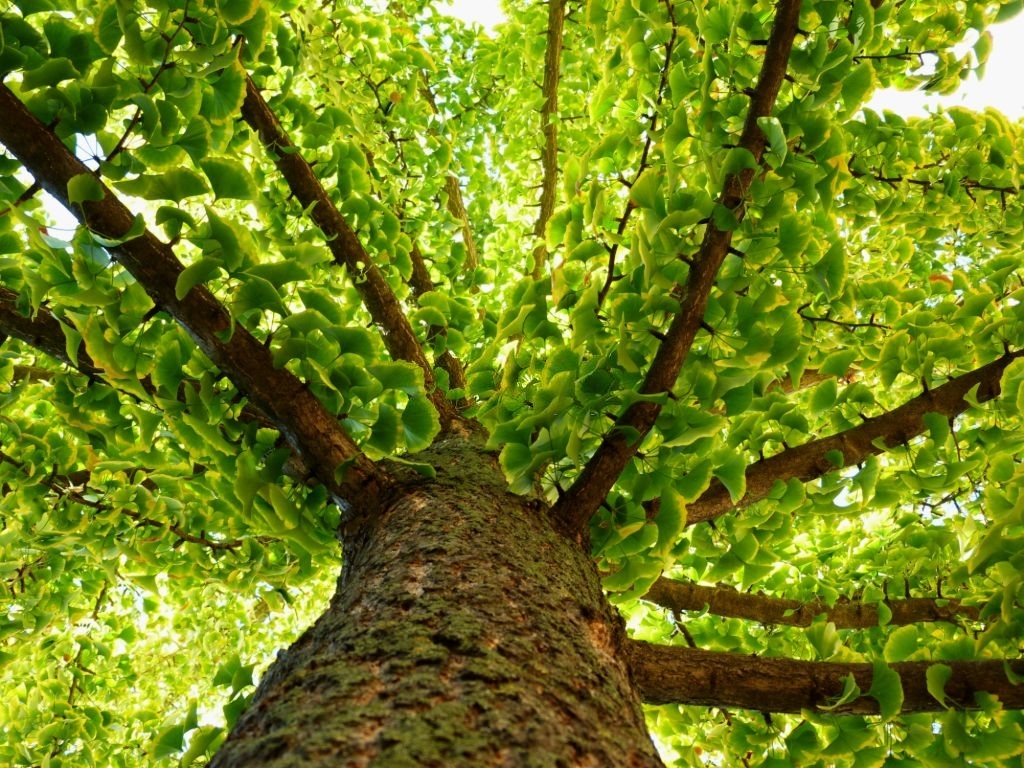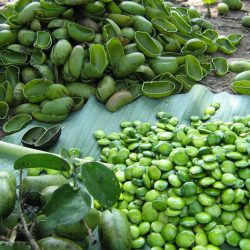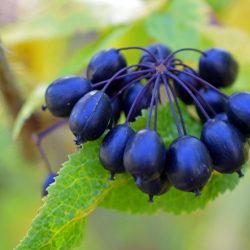The oldest medicinal plants in the vegetable kingdom are, as Darwin said , a veritable “living fossil”. Ginkgo is part of a plant group that developed in the Carboniferous, during the heyday of giant horsetails, 200 to 250 million years ago. Among other things, this tree has the advantage of being able to age for millennia . If we generally agree that 4000 years is a respectable age for a ginkgo.
A little history
A botanical curiosity , Ginkgo produces no flower, fruit or seed. What is considered to be the fruit of the ginkgo is nothing but a huge egg cell. In addition, like an oviparous animal, the ginkgo lays eggs! It is therefore distinguished from viviparous plants on this point. No insect feeds on its leaves and fruits, it resists fungi and supports atmospheric pollution as well as soil pollution. A ginkgo charred in the atomic explosion in Hiroshima on August 6, 1945 even produced a sprout the following spring. The persistence of ginkgo can also be explained by the length of its reproductive period although it becomes sexually mature between the ages of 40 and 70.
This tree is more and more often planted in urban areas. We prefer the golden autumn rains; in fact, the buttery yellow foliage falls over a very short period and highlights the origin of one of the nicknames of ginkgo, the tree with 1000 crowns . This name is directly linked to the arrival of ginkgo in Europe in the 18th century.
The Chinese medicine became interested first therapeutic virtues of ginkgo. It was Chen Nong who described it as a circulatory stimulant 2700 BC. JC. However, it was not until the beginning of the 20th century that pharmacological research began. In 1936, a Hungarian doctor Szent Györgyi , highlighted the presence and the role of the famous flavonoids contained in the leaves of the ginkgo. Therapeutic applications have since multiplied, to such an extent that this primitive tree offers hope in the treatment of Alzheimer’s disease.
What are the main pharmacological properties of Ginkgo biloba leaves?
Neuroprotective and anti-degenerative properties:
The neuroprotective activity of ginkgo is in fact linked to its flavonoids and terpenes, which act synergistically. It notably involves an action on the state of cellular oxidation, the neurotransmitter systems, the cerebral blood flow, and the rate of nitrogen monoxide, but it also includes a non-cholinergic activity , notably involving mitochondrial, cytoprotective mechanisms. and anti-apoptotics.
Ginkgo has in fact potential effects in senile dementia or Alzheimer’s disease comparable to Donepezil.
Anti-ischemic properties:
In vivo , the pretreatment with a ginkgo extract before cerebral ischemia-reperfusion makes it possible to reduce the volume of the infarcted zone by limiting neuronal cell death.
In the elderly, pretreatment with bilobalide before cerebral ischemia makes it possible in particular to reduce the release of glutamate and the size of the infarcted area, to preserve the ATP levels of the ischemic brain, to limit the mitochondrial swelling induced by calcium , and improve sensorimotor functions.
Ginkgo biloba exerts a cardioprotective effect after ischemia-reperfusion, both in healthy subjects, by reducing the size of the infarcted area and in diabetic subjects .
Cerebral and peripheral vasodilator and vasculoprotective properties:
In vivo , the addition of G. biloba to an endothelial cell line causes the modification of membrane permeability by acting on certain ion channels, and causes the release of prostaglandin PG12 from the aortic vascular endothelium. The ginkgo extract also exerts a vasorelaxant activity in vivo by inducing the release of nitrogen monoxide (= nitric oxide = NO) by the cerebral basilar endothelial cells. In the elderly, ginkgo extract exerts a protective effect on the mesenteric arterioles, thus improving vascular elasticity.
There is ultimately a growing number of clinical studies showing the interest of extracts of G. biloba in cardiovascular and peripheral vascular diseases and during vascular complications of diabetes, in relation to their antioxidant and free radical scavenging activities, membrane stabilizer, PAF inhibitor, vasodilator and metabolism regulator.
The plant is also believed to have a favorable effect in age-related macular degeneration ( AMD ), as two studies involving 119 people seem to indicate.
Property on the improvement of cognition and brain plasticity:
In vivo , ginkgo acts as a “cognitive enhancer”, improves synaptic plasticity in hippocampal cells, which it protects against oxidative stress , and cognition in elderly subjects. which could in fact alleviate their deficit in spatial learning and memory . In them, the long-term administration of Ginkgo biloba extract notably improves spatial memory and motivation with significant changes in the content and metabolism of monoamines in several regions of the brain.
Property on vertigo:
The Ginkgo biloba extract EGb 761 improves in vivo the vestibulo-ocular motility , the vestibulo-spinal compensation and mobility in a animal model vertigo (unilateral labyrinthectomy).
Rheological properties:
The improvement in the blood flow induced by ginkgo at the micro and macro-circulation level is linked to the improvement of the deformability of red blood cells, the decrease in fibrinogen levels, the improvement of blood viscosity and vaso-elasticity, especially in diabetic patients.
Other properties:
-
Lipid-lowering:
A 2018 meta-analysis suggests that Ginkgo biloba leaf extracts indeed constitute an adjuvant treatment when combined with statins to manage dyslipidemia and that their combination improves blood lipid parameters compared to statin treatment. uniquely.
-
Antivirals:
The ginkgétine , a flavonoid of ginkgo inhibits sialidase of the influenza virus. In vivo , it significantly improves the survival of subjects infected with the influenza virus .
-
Anticancer drugs:
In vitro, ginkgetin induces autophagic cell death in non-small cell lung cancer .
-
Anti-vitiligo:
Several clinical studies also seem to indicate a favorable activity of the plant in this depigmenting disease of the skin. A 2011 open-label pilot clinical trial conducted in 12 patients aged 12 to 35 for 12 weeks ultimately showed that taking 60 mg of a ginkgo extract significantly improves the extent of vitiligo in the skin.
Ginkgo decreases depigmentation and improves repigmentation in vitiligo .
Are there any precautions for use with Ginkgo biloba?
Toxicity:
- Ginkgo seeds should not be eaten as they contain potentially toxic alkaloids .
Contraindications:
- Contraindicated in hemophilia.
- Contraindicated in pregnant or breastfeeding women; the antiplatelet properties of ginkgo could therefore prolong the bleeding time. During lactation, the safety of the ginkgo leaf is unknown and should be avoided until high quality studies are conducted in humans to prove its safety.
Precautions for use:
- Stop treatment 3 days before surgery.
- According to the EMA, in the absence of sufficient data, the use of medicines containing ginkgo biloba is not recommended in children and adolescents under 18 years of age.
- Ginkgo is useless in herbal teas.
- Several pharmacodynamic studies suggest that ginkgo inhibits platelet aggregation ( ginkgolide B ).
- Apart from acute indications such as hemorrhoidal crisis, the duration of treatment with ginkgo biloba had to last at least 3 months (8 weeks according to the EMA) to be able to benefit from its benefits.
Drugs interactions :
- Care should be taken and medical supervision should be ensured if ginkgo biloba is combined with anticoagulants or with antiplatelet agents. It is the same if taken together with anti-inflammatory drugs, anticonvulsants, sedatives and antiepileptics.
- The rheological effects of ginkgo can be added to those of plants with anticoagulant or blood thinning properties.
- Ginkgo biloba should not be combined with:
- Drugs from the benzodiazepine class, because ginkgolides act as gamma-aminobutyric acid (GABA) receptor agonists
- Oral blood thinners, such as warfarin
- Aspirin (increased bleeding time)
- Nonsteroidal anti-inflammatory drugs (NSAIDs), because by acting on the platelet aggregation factor (FAP) they decrease aggregation
- Action on CYP3A4, 2C9 and 2C19 cytochromes
How to take Ginkgo biloba and in what dosage?
Dry form:
- As a food supplement, in the form of standardized fresh plant extract, dry or standardized extract, aqueous extract, powder, in capsules or tablets or in bulk.
Liquid form:
- Standardized fresh plant fluid extract : 5 ml twice a day in water
- Macérât-mother of buds : 10 to 30 drops per day without meals
- Hydroalcoholic extracts , mother tincture: 20 to 40 drops 2 to 3 times a day in a glass of water
Ginkgo biloba in masterly preparation of standardized extracts in liquid form (EPS)
Association with ginseng :
For improving cognitive performance, especially during intellectual work before exams, competitions or during intense cognitive stress.
Association with astragalus and turmeric :
For cardiovascular protection after 60 years (protection against tissue and brain aging).
Association with horsetail :
In the event of delayed healing, prevention of keloids and stretch marks, cardiovascular prevention and protection in the elderly, prevention of aging.
Association with St. John’s Wort :
In mild to moderate depression with cognitive brain slowdown.
Association with feverfew :
Against headaches, migraines, especially in a context of cerebral circulatory insufficiency.
Association with plantain :
To fight against asthma, chronic obstructive pulmonary disease, due to the ability of ginkgo to inhibit platelet activating factor (PAF).
Medical bibliographic sources and clinical trials :
- Abdel-Kader R. et al., Stabilization of mitochondrial function by Ginkgo biloba extract (EGb 761), Pharmacol. Res, 2007
- Bastianetto S. et al., The Ginkgo biloba extract (EGb 761) protects hippocampal neurons against cell death induced by beta-amyloid; Eur J Neurosci, 2000
- Schwarzkopf TM et al., Neuroprotection by bilobalide in ischemia: improvement of mitochondrial function, Pharmazie, 2013
- O’barr S. et al., Expression of the protooncogene blc-2 in Alzheimer’s disease brain, Neurobiol. Aging, 1996
- Sung JH et al., Ginkgo biloba extract (EGb 761) prevents the ischemic brain injury-induced decrease in parvalbumin expression, Lab Anim Res, 2012
- Chen X. et al., Extracts of Gingko biloba and ginsenosides exert cerebral vasorelaxation via a nitric oxide pathway; Clin Exp Pharmacol. Physiol, 1997
- Miki K., Nagai T., Suzuki K. et al., Anti-influenza virus activity of bioflavonoids, Bioorg Med Chem Lett., 2007
- Shu Lou J. et al., Ginkgetin, a biflavonoid derived from leaves of Ginkgo biloba; induces autophagic cell death in non-small cell lung cancer via p62. Cancer Chemistry, 2017
- Szuczurko O. et al., Ginkgo biloba for the treatment of Vitiligo vulgaris: an Open Label Pilot Clinical; BMC Complementary and Alternative Medicine, 2011
- Doraiswamy PM, Non-cholinergic strategies for treating and preventing Alzheimer’s disease, CNS Drungs, 2002







